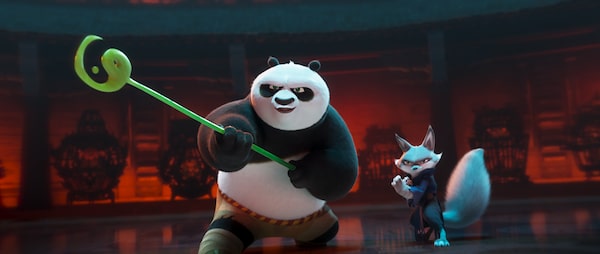Kung Fu Panda 4
Directed by Mike Mitchell, Stephanie Ma Stine
Written by Jonathan Aibel, Glenn Berger, Darren Lemk
Starring Jack Black, Awkwafina, Viola Davis, Dustin Hoffman, James Hong, Bryan Cranston, Ian McShane and Ke Huy Quan
Classification G; 94 minutes
Opens in theatres March 8
Most kids enthusiastically lining up for Kung Fu Panda 4 won’t remember when this franchise kicked our cynical expectations sky high. They weren’t even born yet.
The first Kung Fu Panda, released in the summer of 2008, came after DreamWorks Animation had exhausted the Shrek franchise and had been floating by on cute wildlife adventures like Shark Tale, Madagascar, Over The Hedge and Bee Movie. The basic premise here was still cuddly animals. But with kung fu! It seemed like a nifty way to capitalize on the post-Kill Bill fetishization of pulpy grind house entertainment, but it turned out to be much more than that.
Jack Black and Dustin Hoffman’s pairing as the voices behind the adorably gluttonous panda Po and the exasperated kung fu master Shifu trying to whip him into legendary status, respectively, was joyous. Where Kung Fu Panda (along with its 2011 sequel) became transcendent was in the animation department: how the golden light hits Shifu’s mountaintop temple, or how an army of iridescent arrows rains down gracefully on the villainous Tai Lung (Ian McShane). Kung Fu Panda and Wall-E (released weeks apart) announced a new era for computer animation, where artists in these big production houses could strive for a visual wit and soulfulness rarely seen.

Po (voiced by Jack Black), left, and Zhen (voiced by Awkwafina) in Kung Fu Panda 4, directed by Mike Mitchell.DreamWorks Animation/Dreamworks
Enter Kung Fu Panda 4, which more or less delivers what we expected before the first movie raised the bar. The animation here pales in comparison to its predecessors – the colours at times just look pale. There are jokes – Black as ever makes the most of Po’s slacker vibes – but fewer and further between. The action sequences are busy but never elegant, which tends to be more than enough for audiences who embrace the Minion-ization of animated entertainment. One of the sequel’s chief charms (and its best defense against criticism) is how it embraces the reality that this franchise has already exhausted its potential.
Panda 4 kicks off with Po milking his “dragon warrior” status. He’s satisfied going through the motions, kicking butt in front of a live audience and merchandizing off his popularity, all while refusing to evolve. Hoffman’s Shifu, sounding tired in ways that go beyond the character’s own impatience, insists it’s time for Po to move on, take the role of teacher and make way for a new dragon warrior. The movie becomes about Po’s refusal to try something new, as he sets off on yet another hero’s journey, this time without the Furious Five – the supporting squadron led by Angelina Jolie’s Tigress must have opted not to renew their contracts.
Franchise fans will be excited to see Ian McShane’s Tai Lung return in the opening scenes, and then immediately feel deflated by what a letdown his presence here actually is. The imposing villain, whose entrance in the original was spectacular cinema pure and simple, is only here because the new baddie voiced by Viola Davis is a shapeshifter called the Chameleon taking Tai Lung’s form.
The Chameleon’s master plan is to steal the kung fu powers from Po’s former foes. She doesn’t make much of an impression because she keeps slithering into someone else’s skin and wasting Davis’s talents. Her defining trait – in keeping with the movie’s hands-in-the-air and shoulders-shrugged intentions – is recycling old material.
What counts for fresh here is bringing a new voice into the fold: Awkwafina’s, which is actually not fresh at all. Her raspy banter has become a staple in animated movies, from Angry Birds 2 to the recent Migration. Here, she plays a slick new ally, an obvious choice to take up Po’s mantle as dragon warrior. She strings him along on an adventure that occasionally succeeds in rehashing the slapstick pleasures of old, a far from terrible way to spend an afternoon with the kids.
Kung Fu Panda 4 leans toward the comforting and familiar, and eventually hits a sentimental note as it genuflects to what came before, something we didn’t see coming.
In the interest of consistency across all critics’ reviews, The Globe has eliminated its star-rating system in film and theatre to align with coverage of music, books, visual arts and dance. Instead, works of excellence will be noted with a critic’s pick designation across all coverage. (Television reviews, typically based on an incomplete season, are exempt.)